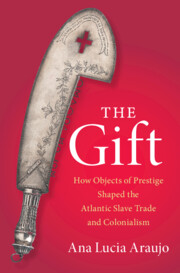Book contents
- The Gift
- Cambridge Studies on the African Diaspora
- The Gift
- Copyright page
- Contents
- Maps and Figures
- Maps
- Acknowledgments
- Introduction
- 1 The Loango Coast and the Rise of the Atlantic Slave Trade
- 2 La Rochelle and Atlantic Africa
- 3 Slave Traders Turned Pirates
- 4 Deciphering the Gift
- 5 A Displaced Gift
- 6 Ngoyo Meets Dahomey
- Conclusion
- Notes
- Bibliography
- Index
6 - Ngoyo Meets Dahomey
Published online by Cambridge University Press: 26 October 2023
- The Gift
- Cambridge Studies on the African Diaspora
- The Gift
- Copyright page
- Contents
- Maps and Figures
- Maps
- Acknowledgments
- Introduction
- 1 The Loango Coast and the Rise of the Atlantic Slave Trade
- 2 La Rochelle and Atlantic Africa
- 3 Slave Traders Turned Pirates
- 4 Deciphering the Gift
- 5 A Displaced Gift
- 6 Ngoyo Meets Dahomey
- Conclusion
- Notes
- Bibliography
- Index
Summary
Following the silver kimpaba displacement from Cabinda to Abomey, this chapter studies how the precious article was received and incorporated in its new home in the royal palaces of the Kingdom of Dahomey, where material culture and objects of prestige were highly valued. Fon artists of Abomey, including silversmiths, appropriated foreign items to create a panoply of articles combining local and foreign elements. The chapter analyzes the silver kimpaba in comparison to other silver articles fabricated by royal silversmiths in Abomey and discusses how the item became an object of prestige and power, until it was looted by the French troops led by Alfred Amédée Dodds in the late nineteenth century. The chapter also discusses the silver kimpabas legacy in Cabinda. As European powers prepared to conquest and colonize the region, they started offering silver swords modeled after the local kimpaba as gifts to local rulers. Overall, the chapter argues, the silver sword embodied the Mfukas increasing power and the fragmentation of Loango coasts societies.
- Type
- Chapter
- Information
- The GiftHow Objects of Prestige Shaped the Atlantic Slave Trade and Colonialism, pp. 121 - 157Publisher: Cambridge University PressPrint publication year: 2023

